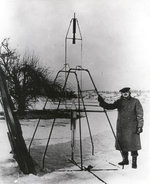Bipropellant rocket
|
|
A bipropellant rocket is a rocket that uses separate fuel and oxidizer propellants. Bipropellant systems are more efficient than monopropellant systems, but they tend to be more complicated because of the extra hardware components needed to make sure the right amount of fuel gets mixed with the right amount of oxidizer (this is known as the mixture ratio.)
Thousands of combinations of fuels and oxidizers have been tried over the years. Some of the more common and practical ones are:
- liquid oxygen (LOX, O2) and liquid hydrogen (LH2,H2) - Space Shuttle main engines, Saturn V, Saturn IB, and Saturn I upper stages as well as Centaur rocket stage
- liquid oxygen (LOX) and kerosene or RP-1 - Saturn V, various Soviet boosters,Delta, Saturn I, and Saturn IB first stages, Titan I and Atlas rockets
- liquid oxygen (LOX) and alcohol (Ethanol, C2H5OH) - early liquid fueled rockets, like German (WW2) A-4, aka V-2, and Redstone
- liquid oxygen (LOX) and gasoline - Robert Goddard's first liquid-fuel rocket
- T-Stoff (80% Hydrogen Peroxide, H2O2) and C-Stoff (methanol, CH3OH, and hydrazine hydrate, N2H4.n(H2O) - Walter Werke HWK 109-509 engine used on Messerschmitt Me 163B Komet a rocket fighterplane of (WW2)
- inhibited red fuming nitric acid (IRFNA, HNO3 + N2O4) and unsymmetric methyl hydrazine (UDMH, (CH3)2N2H2) Soviet Scud-B,-C,-D, aka SS-1-c,-d,-e
- nitric acid 73% with dinitrogen tetroxide 27% (=AK27) and kerosene/gasoline mixture - various Russian (USSR) cold-war ballistic missiles, Iran: Shahab-5, North Korea: Taep'o-dong-2
- hydrogen peroxide and kerosene - UK (1970s) Black Arrow, USA Development (or study): BA-3200
- hydrazine (N2H4) and red fuming nitric acid - Nike Ajax Antiaircraft Rocket
- Aerozine 50 and dinitrogen tetroxide - Titans 2–4, various Soviet rockets, Apollo lunar module, Apollo service module, interplanatary probes (Such as Voyager 1 and Voyager 2
- monomethylhydrazine (MMH, (CH3)HN2H2) and dinitrogen tetroxide - Space Shuttle Orbital maneuvering system (OMS) engines
The best mixture oxygen and hydrogen suffers from the deep temperature (20 K (−253 °C)) which is needed to store the fuel. Also the low density (70 kg/m3), which makes the need for large and heavy tanks, is a disadvantage. The use of lightweight foam, to insulate the cryogenic tank, proved to be dangerous as seen in the Columbia (STS-107) accident. For storable ICBMs or interplanetary spacecraft, the cooling is an unsolvable problem. Because of this the mixtures of hydrazine and its derivatives in combination with nitrogenoxides are used for these rockets.
Small scale rocket engines
XCOR Aerospace (http://www.xcor.com), a California based company, is developing small scale rocket engines to power small airplanes for suborbital flights. They have tested various combination of propellants including nitrous oxide/propane, nitrous oxide/alcohol, LOX/alcohol, LOX/kerosene with success.
See also
- spacecraft propulsion
- tripropellant rocket
- hypergolic rocket fuels


